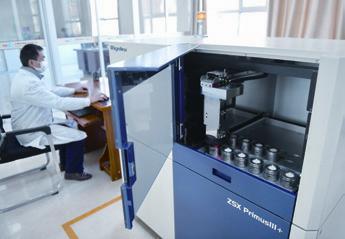THE INNOVATION GAME
2020-05-11ByJiangJiang
By Jiang Jiang

International attention has focused re-cently on Chinas notable improvement in its innovation capacity. Organizations such as the World Intellectual Property Organization (WIPO) and the U.S. National Science Foundation (NSF) have issued successive global innovation indexes demonstrating that China is experiencing a growing momentum.
It is undeniable that indicators from these think tanks and authorities are of great credibility and reliability. However, they are only part of the story. For some time now, Chinas scientifi c and technological strength has been advancing, but its achievements have been mainly reflected by scale and speed, as its innovation capacity still lies in the second echelon, with a long way to go before it ascends to among the worlds top innovators.
Written affirmation
WIPOs report stated that Chinas innovation capacity ranking rose to 14th in 2019 from 17th in 2018 and 22nd in 2017. The number of research personnel, patent and scientifi c publications also rose. The sci-tech cluster strength of Chinas Shenzhen and Hong Kong Special Administrative Region ranked second globally and the innovative performance of emerging economies in the country is continuously improving. Chinas progress can be epitomized in two aspects: the total volume of many indicators have advanced to the top and the international impact of its innovation has been enhanced.
According to an NSF science and engineering index report, in the fi rst 15 years of the 21st century, Chinas annual research and development (R&D) expenditure grew at an average rate of 20 percent, contributing nearly one third to global R&D growth. According to World Bank calculations, Chinas R&D investment accounts for a quarter of the global total, second only to the U.S. From the perspective of R&D intensity, the ratio of a countrys investment in R&D against its GDP, Chinas index is higher than the average level of 15 EU countries.
In addition, the talent pool expanded during those 15 years, according to the NSF report, while the growth rate of the number of bachelors degrees obtained in the field of science and engineering in China was much higher than that in the U.S. and the EU. The Ministry of Science and Technology also stated that the total number of sci-tech personnel in China ranks fi rst in the world. A sci-tech index report by the Organisation for Economic Co-operation and Development showed that the total size of Chinas R&D personnel is second only to the U.S.
The NSF report also showed that the number of papers published by China in the field of science and engineering has surpassed that of the U.S., making it fi rst in the world. According to data released by WIPO, the number of Chinese patent applications via the Patent Cooperation Treaty has increased by more than 10 percent annually since 2003, and surpassed that of the U.S. to become the worlds largest in 2019
The impact of scientific and engineering publications have also improved. The index of the proportion of the top 1 percent of papers cited measures the quality and standard of scientific engineering publications in a country or region. According to NSF data, in the first 15 years of the century, Chinas index has gradually increased from 0.4 percent to 1 percent.
In addition, China sees its attraction to innovation capital dramatically rise. Currently, its venture investment accounts for about a quarter of the worlds total, while the U.S. accounts for more than half. It is worth noting that since 2013, the amount of venture investment in China has been growing rapidly, increasing more than 10 times in five years.
In 2016, the added value of Chinas hitech manufacturing accounted for about a quarter of the worlds total, ranking second after the U.S., and it accounted for more than one third of the global share in the information and communications technology industry, ranking first in the world.
Objective overall view
International views of Chinas thriving innovation capacity are mainly based on the quantity and growth rate of indicators such as R&D spending, human resources, publications and patents. But despite its progress, Chinas innovation capacity is not as strong as traditional technology powerhouses such as the U.S., Germany or Japan.

For instance, Chinas expenditure on innovation is far less than developed countries. Its accumulated R&D spending from 2000 to 2015 was only 43 percent of that of the U.S. Meanwhile, the R&D intensity of the U.S. has stayed above 2 percent since the 1990s, while China didnt hit 1 percent until 2002. Although an expanded scale of training has resulted in an increasing number of research personnel as a remedy for earlier extreme shortages of talent, China still needs more research staff, considering its total labor market. Nine out of every 1,000 employees are research staff in countries like the U.S., the UK and Germany. In China, the number is only 2.09, which is one fifth that of Japan and one fourth that of the average European level.
Moreover, the output of innovation is lower. Statistics from Bloomberg showed that the U.S. total number of patents has surpassed 3 million since the 19th century, while California alone processes twice as many as Germany, which ranks third in the world. Japan, which ranks second, owns about 1 million patents, and China is not even among the top 10 countries.
Although in recent years Chinas number of publications in the field of science and engineering has increased fast, in most years since 2003, it is less than that of the U.S. As for the accumulated number of publications, the total number of papers in the field is less than 70 percent of that of the U.S. From the perspective of the exportation of innovation results, the long-term surplus of the U.S. in global intellectual property trade has not changed. U.S. global patent licensing income has occupied half of the worlds share for several consecutive years, while that of China is less than 1 percent of the U.S.
Also, Chinas number of highly innovative enterprises is small. In emerging sectors such as bioscience, information and new materials, Chinese companies lead the pack not because of their technology prowess but because they have more clients and a larger sales volume. China still has a big gap with developed countries in core technologies and lacks major original technological achievements that can generate major changes for industries.
China also falls short of innovative talent. According to the Global Talent Competitiveness Index released by the European Institute of Business Administration and other organizations, Switzerland still ranks first in the world in terms of talent competitiveness, followed by Singapore and the U.S. Although Chinas ranking in the index has risen, it still falls midway on the list. Only six Chinese cities are on the list of the top 100 cities for talent attraction, while top-ranking Beijing is placed 55th. In terms of attracting overseas students, China has always been a net exporter instead of an importer of international students.
Feasible guidelines
It is important to optimize the innovation environment. Reform of the administrative approval system should be deepened to reduce institutional barriers. As key innovation players, companies should be endowed with greater dynamism and flexibility. Government spending should be earmarked for non-profitable basic research. Market-oriented incentives such as government equity investment in scitech fields and loan discounts should be improved.
It is essential to integrate into global innovation networks and attract high-end innovative enterprises and talents to settle down in China. The building of large-scale scientific research infrastructure, such as national-level comprehensive innovation centers, industrial innovation centers and scientific facilities, should be accelerated, in an effort to strengthen R&D in common technology and solidify the foundation for industrial innovation.
